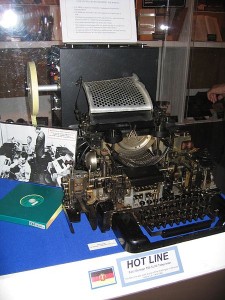Good morning.
We’ve an even chance of thunderstorms this afternoon, with a high of ninety-one, and southwest winds five to fifteen mph.

This Teleprinter was used from 1963-1980 as a part of the special transatlantic Moscow–Washington hotline, also known as “The Red Line”. This Rotor machine is currently on display at the National Cryptologic Museum, located on the National Security Agency (NSA) campus at Fort Meade, Maryland.
On this day in 1963, a hotline between America and the Soviet Union:
Two months after signing an agreement to establish a 24-hour-a-day “hot line” between Moscow and Washington, the system goes into effect. The hot line was supposed to help speed communication between the governments of the United States and the Soviet Union and help prevent the possibility of an accidental war.
In June 1963, American and Russian representatives agreed to establish a so-called “hot line” between Moscow and Washington. The agreement came just months after the October 1962 Cuban missile crisis, in which the United States and Soviet Union came to the brink of nuclear conflict. It was hoped that speedier and more secure communications between the two nuclear superpowers would forestall such crises in the future. In August 1963, the system was ready to be tested. American teletype machines had been installed in the Kremlin to receive messages from Washington; Soviet teletypes were installed in the Pentagon. (Contrary to popular belief, the hot line in the United States is in the Pentagon, not the White House.)
Both nations also exchanged encoding devices in order to decipher the messages. Messages from one nation to another would take just a matter of minutes, although the messages would then have to be translated. The messages would be carried by a 10,000-mile long cable connection, with “scramblers” along the way to insure that the messages could not be intercepted and read by unauthorized personnel. On August 30, the United States sent its first message to the Soviet Union over the hot line: “The quick brown fox jumped over the lazy dog’s back 1234567890.” The message used every letter and number key on the teletype machine in order to see that each was in working order. The return message from Moscow was in Russian, but it indicated that all of the keys on the Soviet teletype were also functioning.
Puzzability concludes a back-to-school series entitled, Welcome, students:
Welcome, Students
For this week’s class act, we started each day with a word or phrase, added the seven letters in the word STUDENT, and rearranged all the letters to get a new phrase. Both pieces are described in each day’s clue, with the shorter one first.
Example:
Skating venues; Tobey Maguire’s Spider-Man love interest
Answer:
Rinks; Kirsten Dunst
What to Submit:
Submit both pieces, with the shorter one first (as “Rinks; Kirsten Dunst” in the example), for your answer.
Here’s today’s puzzle:
Friday, August 30:
Preparing one’s hands for a gymnastics routine; ended a gymastics routine perfectly
